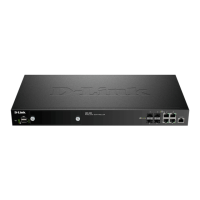D-Link DWC-2000 User Manual 91
Section 4 - Advanced WLAN Conguration
Field Description
Automatic Power
The power level aects how far an AP broadcasts its RF signal. If the power level is too
low, wireless clients will not detect the signal or experience poor WLAN performance. If
the power level is too high, the RF signal might interfere with other
APs within range.
Automatic power uses a proprietary algorithm to automatically adjust the RF signal to
broadcast far enough to reach wireless clients, but not so far that it interferes with RF
signals broadcast by other APs. The power level algorithm increases or decreases the
power level in 10% increments based on presence or absence of packet retransmission
errors.
Default Power
The automatic power algorithm will not reduce the power below the number you set in
the default power eld. By default, the power level is 100%. Therefore, even if you enable
the automatic power, the power of the RF signal will not decrease. The power level is a
percentage of the maximum transmission power for the RF signal.
APSD Mode
Select Enable to enable Automatic Power Save Delivery (APSD), which is a power
management method. APSD is recommended if VoIP phones access the network through
the AP.
Frag Threshold
The fragmentation threshold limits the size of packets transmitted over the network.
Acceptable values are even numbers from 256‐2345. Packets that are under the congured
size are not fragmented. A value of 2346 means that packets are not fragmented.
Short Retries
The value in this eld indicates the maximum number of transmission attempts on frame
sizes less than or equal to the RTS Threshold. The range is 1‐255.
Long Retries
The value in this eld indicates the maximum number of transmission attempts on frame
sizes greater than the RTS Threshold. The range is 1‐255.
Transmit Lifetime
Shows the number of milliseconds to wait before terminating attempts to transmit the
MSDU after the initial transmission.
Receive Lifetime
Shows the number of milliseconds to wait before terminating attempts to reassemble
the MMPDU or MSDU after the initial reception of a fragmented MMPDU or MSDU.
Station Isolation
When this option is selected, the AP blocks communication between wireless clients. It
still allows data trac between its wireless clients and wired devices on the network, but
not among wireless clients. This feature is disabled by default.
• To enable Multicast and Broadcast Rate Limiting, click ON.
• To disable Multicast and Broadcast Rate Disabled, click OFF.
Primary Channel
This setting is editable only when a channel is selected and the channel bandwidth is set
to 40 MHz. A 40‐MHz channel can be considered to consist of two 20‐MHz channels that
are contiguous in the frequency domain. These two 20‐MHz channels are often referred
to as the Primary and Secondary channels. The Primary Channel is used for 802.11n clients
that support only a 20‐MHz channel bandwidth and for legacy clients. Use this setting to
set the Primary Channel as the upper or lower 20‐MHz channel in the 40‐MHz band.
Short Guard Interval
The guard interval is the dead time, in nanoseconds, between OFDM symbols. The guard
interval prevents Inter‐Symbol and Inter‐Carrier Interference (ISI, ICI). The 802.11n mode
allows for a reduction in this guard interval from the a and g denition of 800 nanoseconds
to 400 nanoseconds. Reducing the guard interval can yield a 10% improvement in data
throughput.
Select one of the following options:
• ON= The AP transmits data using a 400 ns guard Interval when communicating with
clients that also support the 400 ns guard interval.
• OFF= The AP transmits data using an 800 ns guard interval.
Radio Resource
Management
Radio Resource Measurement (RRM) mode requires the Wireless System to send
additional information in beacons, probe responses, and association responses.Enable or
disable the support for radio resource measurement feature in the AP prole. The feature
is set independently for each radio and is enabled by default.

